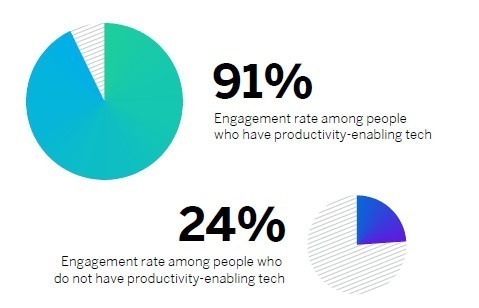“We choose flexibility.”
That’s the big takeaway from Qualtrics’ 2022 Employee Experience Trends report — based on input from 14,000 employees worldwide.
Since the pandemic struck in 2020, the work world and all of those in it have been in a state of flux. Things have changed from a mass exodus of many employees to work-from-home settings to a return to quasi-normal work within a hybrid environment.
Those changes, though, had led many employees to recognize the significant benefits that working from home provided—from greater flexibility in their schedules to reduced expenses to more time available to spend with family when their work commutes were reduced from, for some people, hours to just a few minutes.
They are, not surprisingly, hesitant to give up those benefits—at least entirely.
HR Challenges Ebb and Flow with Opportunities for Improvement
Input from full-time employees in 27 countries, with a comparison to 2021 results, suggest some critical areas for employers to continue to focus on for the most significant impact:
- Engagement—at 66% in both 2021 and 2022.
- Intent to stay—dropping from 70% in 2021 to 65% in 2022.
- Growth and development—increasing in importance from 63% in 2021 to 68% in 2022.
- Manager effective/trust in leadership—up from 63% in 2021 to 67% in 2022, but still need continued focus.
- Employee well-being—remains steady at 72%.
- Corporate social responsibility—declining from 72% in 2021 to 66% in 2022.
These are the challenges HR leaders and their organizations faced in 2022 and will continue to face in 2023.
They are challenges driving a host of responses from employees that organizational leaders and HR professionals are scrambling to address—from the “great resignation” to “quiet quitting.” It’s an environment where, despite a declining economy, employees, in many cases, still have the upper hand. While workers may be plentiful, good workers remain in short supply, especially for certain high-demand and hard-to-find roles.
And, of course, even fully employed organizations want those employees to be fully engaged. Productivity matters in a competitive environment where margins are continually squeezed and time is money, especially in a large service economy.
Here are the trends Qualtrics point to as requiring focus now for companies to get ahead of the curve when it comes to engaging and retaining top talent.
An Exodus of Leaders, Especially Women
Working during the pandemic while simultaneously dealing with personal demands related to caring for family members, serving as a proxy for teachers as children learned from home, and addressing ongoing concerns for both physical and mental health took a toll.
Employees—and their managers—are increasingly burned out.
According to an Aflac study, “more than half (59%) of American workers are experiencing at least moderate levels of burnout, a notable increase over 2021 (52%) and on par with the levels reported in 2020 at the height of the COVID-19 pandemic.”
Things aren’t getting better; they’re getting worse.
And they’re getting significantly worse for women. Qualtrics’ data on leaders’ intent to stay has dropped dramatically, but women’s results are considerably lower than their male colleagues.
Women’s intent to stay dropped 8 points between 2021 and 2022. Those who lead other leaders dropped even more—by 21 points.
What can organizations do to support their leaders, both male and female? Qualtrics suggests:
- Providing the technology and talent resources they need.
- Providing training and toolkits to help navigate burnout and stress.
- Work with leaders to reassess targets and productivity.
- Make it easier for leaders to access support materials.
Stress and burnout in the workplace can’t be ignored. It’s essential to take steps to recognize and address the toll the last few years have taken and to work with staff to help minimize the stressors they’re being impacted by.
Demand for Better Workspaces—Both Physical and Digital
Despite some employers’ primarily failed efforts to demand that employees return to the workplace, most analysts point to a continuation of remote or hybrid work into the future. Gallup, for instance, reports that about half of the full-time workforce in the US, or 60 million people—say they can do their current job remotely for at least part of the time. The shifts in preferences for remote vs. onsite work have changed dramatically from pre-pandemic to today:
- Fully remote: from 8% preferring pre-pandemic to 32% choosing today.
- Hybrid: from 32% choosing pre-pandemic, to 59% today.
- Fully onsite: from 60% preferring pre-pandemic to 9% today.
Hybrid work is here to stay, Qualtrics says. But, they add: “there’s a gap between what organizations think they’re delivering and what employees want when it comes to hybrid work enablement.”
Impacting that gap is the availability of the technology needed to do their work effectively. “Only 30% of respondents said their experience with their company’s technology exceeds or greatly exceeds their expectations.”
What do employees want to help them feel more productive and engaged? According to Qualtrics:
- Flexibility in where they work.
- Technology that allows them to collaborate.
- Open, honest, and transparent communication from their organizations.
- Support in their efforts to adapt to organizational changes.
- Reimagined office spaces.
Moving forward, HR and IT leaders need to collaborate to create a better work environment focusing on designing a hybrid work experience that will work for everyone, no matter where they may be physically located. Keep in mind that, for most organizations, this will be a more than one size fits all solution. They’re likely to have employees working in all three settings—on-site, hybrid, and fully remote.
Expectations for Continued DEIB Progress
Diversity, equity, inclusion, and belonging have been top-of-mind for most organizations since the events and social unrest following George Floyd’s murder in 2020, shortly after the pandemic began. Despite company efforts, though, employees are far from satisfied with the progress being made.
Qualtrics’ research indicates that only 70% say their companies have made sufficient progress—only 67% say senior leaders’ actions indicate that they’re committed to building a diverse and inclusive culture.
In an environment where talks of recession loom, there’s a tendency on the part of some companies to put DEIB efforts and investments on the back burner. CEOWorld points to a recent KPMG CEO Outline that notes that while CEOs feel environmental, social, and corporate governance (ESG) programs are important, “59% said they plan to pause or reconsider their organization’s ESG efforts in the next six months as they adjust their strategy to prepare for a recession.”
That may be short-sighted thinking, especially as it related to talent acquisition and retention.
Perceptions around the DEIB support their organizations provide has a marked impact on intent to stay with the organization.
Here, again, there is a disconnect between employer and employee sentiment with 80% of senior leaders saying their actions show they’re committed to DEIB, but only 58% of individual contributors agreeing.
There is good news here, though: “employee perceptions of DEIB efforts and corporate social responsibility have improved year-over-year.” Still, it’s important to double down on this commitment and make sure that DEIB is a focus and that targets are met.
The Need to Address Employee Wellbeing
Employee wellbeing was already a concern for many organizations prior to the pandemic. It’s even a greater concern now.
Research from The Hartford indicates that 42% of US employees say their mental health has declined since the pandemic began. They report declines in social (41%), financial (32%) and physical (29%) health and wellbeing.
“People are burnt out from a workplace culture that doesn’t support, sustain, or restore employee well-being,” Qualtrics says. Their research indicates that even when they have time off benefits available, many are hesitant to use them.

There are no easy fixes to address the issue despite some organization’s attempt to address burnout with simple fixes like “a mental health app or a week off.” The focus, Qualtrics says, needs to be on addressing “a toxic culture that rewards workplace martyrdom over self-care (and self-awareness).”
They recommend:
- The leaders practice what they preach, showing through their own actions and behaviors that they are “working reasonable hours, taking personal time, treating their mental and physical health as a priority, and then encouraging their people to do the same.
- Talking to employees about mental health to help remove its stigma.
- Encouraging a culture of wellbeing.
In addition, Qualtrics notes that employees themselves have a role to play here: “it’s employees who dictate the culture by establishing their own boundaries with work, communicating with their managers about workload, and taking ownership of restorative time outside of work.”
Employee engagement and wellbeing is a shared responsibility among organizational leaders, their HR advisors, managers, supervisors, and employees themselves. It’s an issue that has been raised to a higher level of awareness—and concern—since the pandemic, and one that remains a concern even as the pandemic has released its hold to a large degree.
Moving forward, organizations need to focus on the work environment—whatever it looks like—to ensure that both technology and leadership capabilities and competencies are designed to support employee needs in a continually shifting and continually demanding environment.



